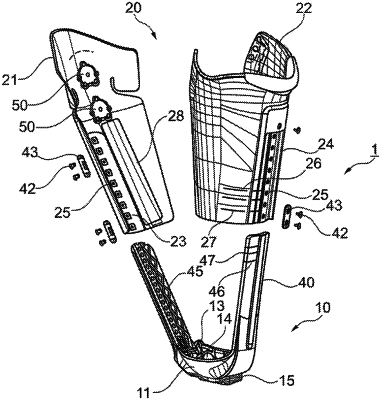| CPC A61F 2/80 (2013.01) [A61F 2/7812 (2013.01); A61F 2002/7818 (2013.01); A61F 2002/7881 (2013.01)] | 23 Claims |

|
1. A prosthetic socket to receive an amputation stump, socket comprising:
a base;
two supports arranged on the base and extending medially and laterally from the base in a proximal direction;
no more than two shell elements, each being attached directly to one of the two supports, each of the shell elements of the two shell elements being at least partially flexible, each shell element of the two shell elements are configured to enclose part of the stump, one of the shell elements of the two shell elements extending medially from the base on one of the two supports and one of the shell elements of the two shell elements extending laterally from the base on one of the two supports,
wherein the two shell elements each comprise at least two different materials, and at least two of the at least two different materials have different thicknesses, the two shell elements each being more rigid in a region proximate the supports than regions of the two shell elements distant from the region proximate the supports; and
a tensioning system arranged partially circumferentially and configured to act upon the two shell elements to compress the stump in at least a distal zone and a proximal zone of the socket, wherein the two shell elements are connectable in different positions, continuously or in predetermined positions, with the associated supports in a force-locking or form-locking manner to provide an adjustable length for the socket.
|